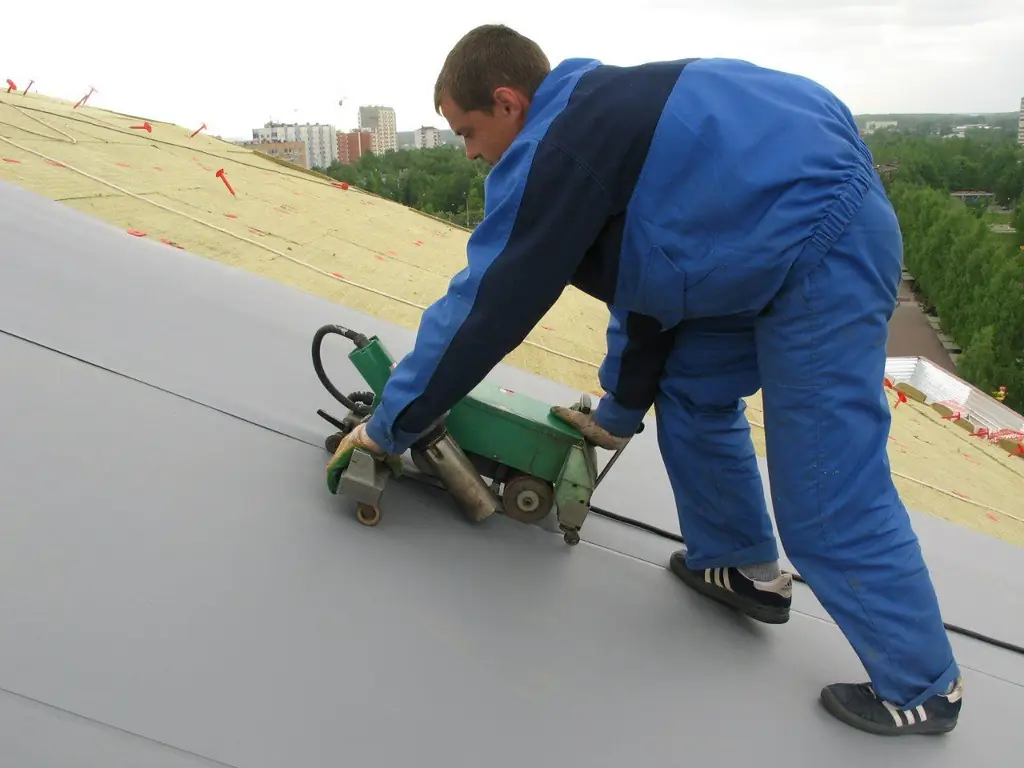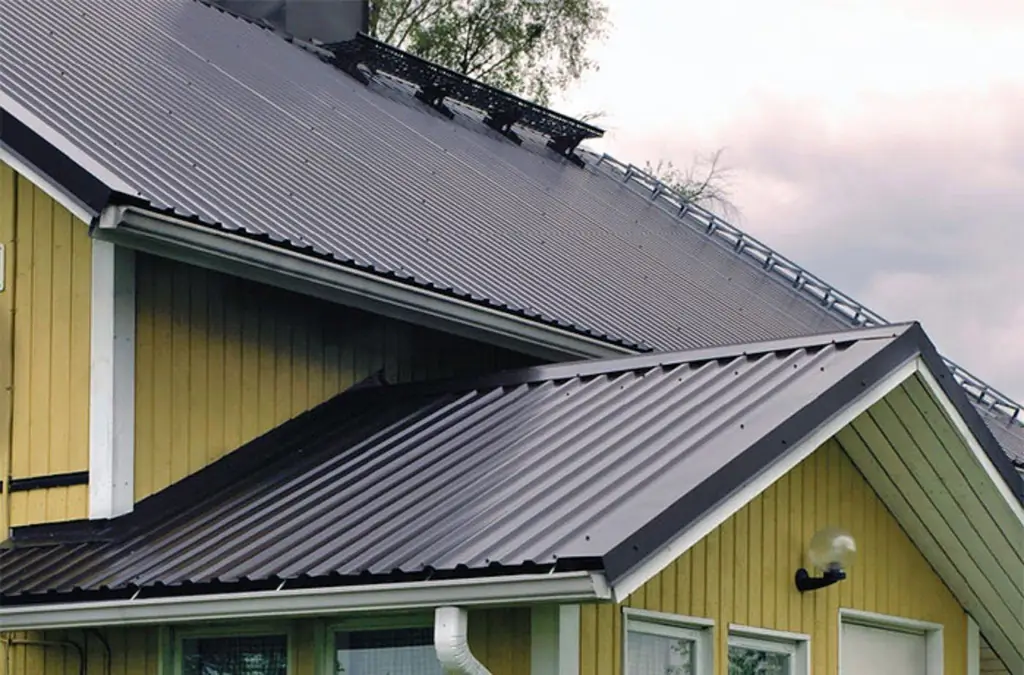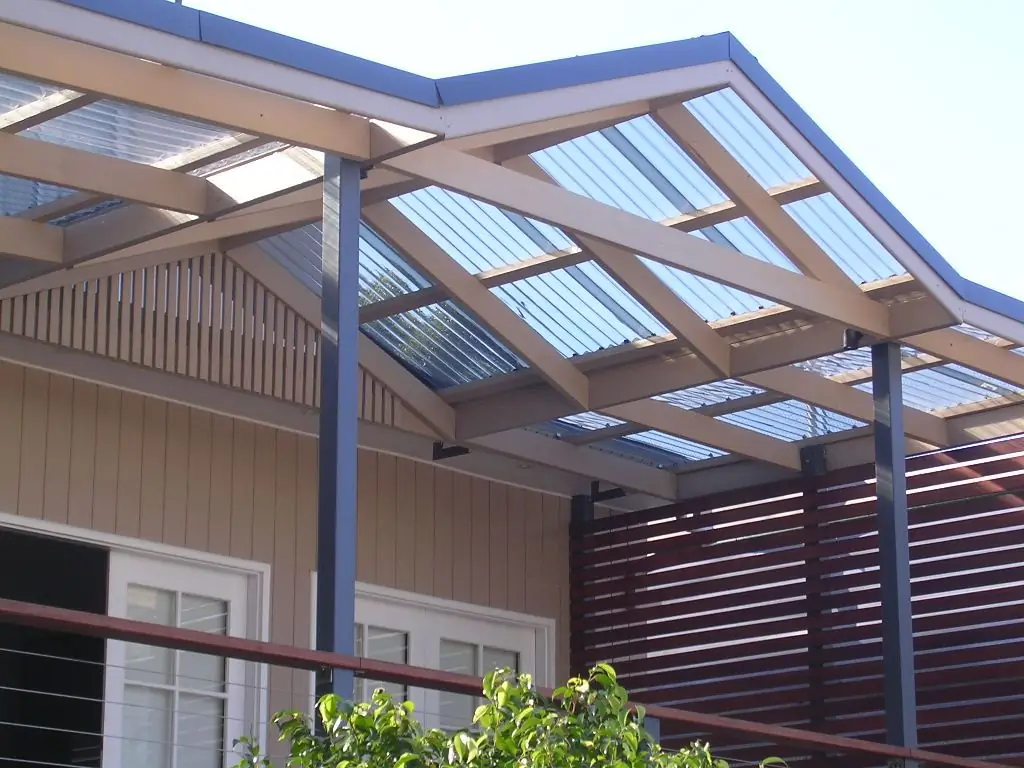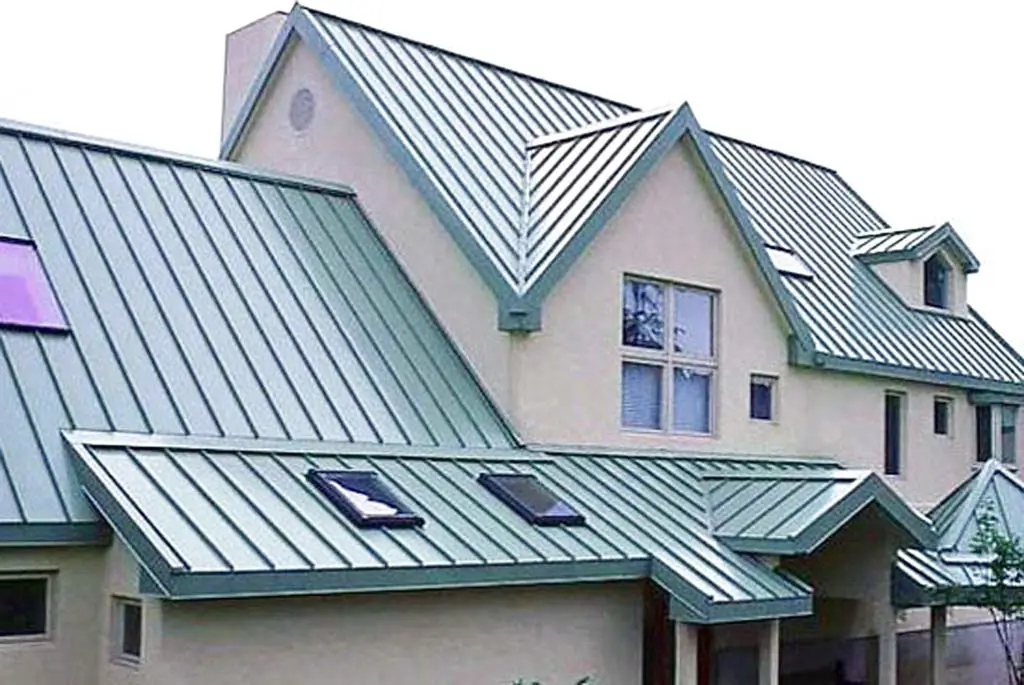
Table of contents:
- Author Bailey Albertson [email protected].
- Public 2023-12-17 12:53.
- Last modified 2025-06-01 07:32.
Features of a membrane roof, rules for its installation and repair

Every year, more and more products for roofing appear on the building materials market. They are characterized by improved performance characteristics, such as increased strength, ease of installation and long service life. One of these innovative roofing materials is membrane roofing, which differs from others not only in excellent characteristics, but also in higher cost.
Content
-
1 Features and characteristics of membrane roofing
- 1.1 Specifications of membrane roofing materials
- 1.2 Advantages and disadvantages
- 1.3 Video: features of a membrane roof
- 2 Membrane roofing tool
- 3 Membrane roofing device
-
4 Features of mounting PVC membrane on the roof
- 4.1 Heat-welded method
- 4.2 Laying by ballasting
- 4.3 Adhesive installation of the membrane
- 4.4 Video: how to make a PVC membrane roof with your own hands
- 4.5 Errors when installing membrane roofs
-
5 Features of the operation of a roof with a membrane covering
- 5.1 Service life of a membrane roof
-
5.2 Repair of PVC membrane on the roof
5.2.1 Video: Applying a patch to a membrane roof
Features and characteristics of the membrane roof
Membrane roofing is a relatively new roofing material that has already become quite popular. Unfortunately, it is not available for every consumer due to its rather high cost. But the high price is compensated by the possibility of self-assembly and a long service life.

Membrane roofing is an innovative but rather expensive material
Specifications of Membrane Roofing Materials
Long service life of the membrane roof is possible due to the presence of a special stabilizer. It is located in the upper layer of the material and is designed to protect the roof covering from external influences, in particular, from wind, ultraviolet rays and precipitation.
A membrane roof has the following physical characteristics:
- material thickness - from 1.2 to 1.5 mm;
- standard roll length - 20 m;
-
roll width - just over two meters.

Roof membrane roll A standard roll of membrane roofing is 20 m long and just over 2 m wide
The mass of the roll depends on the thickness of the material. Usually it is 1.4-1.6 kg per 1 m 2 of surface. That is why such a roof will not exert strong loads on the roof truss system. Combined with its high tensile strength, this material can be considered one of the best coatings for any type of roof.
Advantages and disadvantages
Membrane roofing has both advantages and disadvantages. The advantages include:
- easy installation, quick installation;
- long service life;
- high resistance to weather conditions and constant temperature drops;
- a high level of strength and elasticity - such a roof will not tear, rust, stain, or be damaged by birds;
- vapor tightness, due to which the possibility of condensation is excluded;
- good waterproofing, allowing you to save money on the purchase of other additional materials for the roofing cake;
- the possibility of mounting both on an uneven roof surface and on its old coating;
- absolute incombustibility, - the membrane material meets all fire safety standards;
- the absence of a large number of seams, which minimizes the possibility of leaks.

Membrane roof is pretty easy to fit with your own hands
When choosing, it is worth remembering about the disadvantages:
- low resistance to solvents and other chemically active substances;
- loss of color during operation;
- unsafe material vapors due to the high amount of plasticizers in its composition;
- high cost, which pays off with a long service life and ease of repair work;
- limited choice of material due to the special technology of membrane roofing.
It is also worth remembering that there are subspecies of membrane roofing, which have their own special disadvantages:
-
TPO coatings are characterized by low elasticity, but this type is the most frost-resistant and durable;

TPO coating TPO membrane is characterized by reduced elasticity and high strength
-
EPDM membranes require an adhesive bond, which reduces the strength of the seams.

EPDM membrane EPDM membranes are mounted by gluing, therefore the coating of this material has many seams
Video: features of a membrane roof
Membrane roofing tool
Installation of a membrane roof can be done independently, but with certain specialized tools:
-
construction hair dryer (the temperature of the air stream should reach 600 o C);

Building hair dryer For the installation of a membrane roof, it is very important to choose the right hair dryer capable of providing the required operating temperature
-
rollers: brass for processing corners and difficult places and rubber, which will not melt under the influence of high temperatures;

Brass roller For rolling the material and other manipulations, you need a brass-coated roller
- a construction knife with which you can easily cut the membrane material;
- special scissors for cutting circles for gluing joints where several layers of membrane are laid;
- drills in the case of a mechanical mounting method (can be replaced with a hammer drill);
- hammer;
- an extension cord that will allow you to work over the entire roof area using an electric tool.
Membrane roofing device
Membrane roofing is able to effectively protect the building from moisture penetration inside, but provided it is properly installed. A typical roofing cake underneath a membrane material consists of the following layers:
-
base - can be any, most often wooden or concrete;

Structure of a roofing cake under a membrane covering Any material can be used as a base for a membrane covering, including corrugated board
- vapor barrier layer - prevents condensation on the insulation;
- insulation, laid in two layers in order to distribute the load. For membrane roofs, mineral wool, extruded polystyrene foam or glass wool are most often used;
-
telescopic fasteners;

Telescopic fasteners For fastening rolls or mats of mineral wool, special dowel-nails with wide heads are used
- PVC membrane.
In the case of membrane roofing on top of the old coating, the structure of the roofing cake will be slightly different:
- if necessary, alignment on top of the existing insulation (the old roof covering is dismantled at the same time), a layer of geotextile is equipped, which serves as a separating material;
- otherwise, the geotextile is laid directly on top of the existing pavement.
Features of installation of PVC membrane on the roof
There are several ways to mount a membrane roof.
Heat-welded method
The heat-welded method involves the use of a special tool with which the edges of the roll are heated, after which they are glued together. The process takes place in the following sequence:
- Cleaning the roof surface.
- Dismantling or repairing old roofing.
-
Installation of a vapor barrier film with an overlap of 10-15 cm and careful gluing of the seams.

Installation of a vapor barrier film Vapor barrier foil prevents condensation from escaping humid and warm air from living quarters
-
Insulation laying. It is recommended to install mineral wool or polystyrene under the membrane roof. Insulation elements must be placed as tightly as possible to each other, while it is desirable to fix them with dowel-nails.

Roof insulation under the membrane covering Insulation is usually laid in two rows and fixed with disc dowel-nails
-
Installation of PVC membrane. It is necessary to lay the sheets with an overlap of 15 cm. The membrane is fixed on the wooden crate with telescopic fasteners with self-tapping screws, on the concrete surface - with dowel-nails.

Mounting the membrane using telescopic fasteners If the roof is laid on a wooden crate, it is convenient to use telescopic fasteners with ordinary self-tapping screws.
-
Seam sealing. The welding machine is positioned at an angle of 45 o and a stream of hot air is directed to the joints of the sheets. After the seams have melted, they must be rolled with a silicone roller.

Sealing seams at the joints of the canvas In order for the seams to melt well, the feed nozzle of the welding machine must be positioned at an angle of 45 degrees to the surface of the roof
Ballast laying
The ballast method of laying the PVC membrane can be chosen only when arranging flat and flat roofs with a maximum angle of inclination of 10 o. The work technology is as follows:
-
Laying of membrane material using telescopic dowel-nails or self-tapping screws.

Laying the membrane under the ballast cover The membrane is rolled out over the roof surface and fixed with telescopic fasteners
- Laying geotextile material. It is not necessary to fasten it, but it is worth taking care of the presence of an overlap, which will help prevent leaks.
-
Ballast filling. A gravel mixture is ideal for membrane roofs. It needs to be distributed evenly over the entire roof surface.

Ballast on a membrane roof Gravel backfill is most often used as ballast.
Adhesive way of laying the membrane
As a rule, the adhesive method of joining seams is used when installing EPDM membranes. The roof is laid in the following sequence:
- Remove all contamination from the roof surface, including debris and antenna wires. If necessary, the coating is repaired.
- Laying a vapor barrier film with an overlap of fabrics (10-15 cm) and insulation.
-
Installation of membrane roofing over the entire surface. First, the rolls just need to be unrolled, and then fix their joints with a special construction glue. The fixing strength of each joint must be checked very carefully.

Gluing the roofing membrane Roof membrane joints can be treated with special glue or sealing tape
Video: how to make a PVC membrane roof with your own hands
Errors when installing a membrane roof
To equip a membrane roof, you need to have at least minimal construction experience. With self-installation, this requirement is not always respected, which is why sometimes mistakes cannot be avoided. The most common ones are:
- Poor gluing of seams. This problem may be due to incorrect temperature selection. It may be too low or too high. In the first case, the seams are deformed, but do not stick to each other, in the second, they stick together, but the seam does not form.
- Insufficient amount of fasteners, as a result of which, due to increased loads, the material may tear.
- Poor insulation fasteners, due to which the material is displaced and cold bridges are formed.
-
Lack of geotextiles. This can lead to leaks, especially if there is no separation layer between the old coating and the membrane.

Geotextile Geotextile acts as a separation layer between the membrane and the old roof covering
Features of the operation of a roof with a membrane covering
Membrane roofing is a relatively new building material, therefore it requires a special approach to maintenance.
Membrane roof service life
The minimum service life of a membrane roof is 10 years. If all maintenance requirements are met, this parameter can be increased by 5 or more times. Roof maintenance must be carried out in accordance with the following requirements:
- During the installation of the roof, in no case should you wear shoes with protruding metal parts. They can damage thin roofing material.
- When cleaning the roof from snow, do not use scrapers that have sharp working edges. It is better to perform this procedure with plastic spatulas.
- In the first two years of operation, streaks may appear on the membrane surface after rain. You do not need to delete them. This phenomenon is short-lived and goes away on its own. Colored stains that may indicate the presence of mold must be removed. You can remove it with oxygen bleach.
Repair of PVC membrane on the roof
If the technology of installing a membrane roof is observed, its repair is required much less often than when using other materials. But sometimes defects still arise, which can be eliminated with your own hands. The most common problems requiring a quick response are:
-
Mechanical damage, in particular, rupture of waterproofing or membrane puncture in various ways. The main method for repairing damage is patching. To do this, you need to thoroughly clean the surface in the damaged area, removing all large debris, treat the damaged area with a special cleaner and solder a patch from a similar roofing material using a construction hair dryer.

Repair of mechanical damage to membrane roofing Almost any problem with a membrane roof can be solved by applying a patch
-
Delamination of welds. Such a problem can arise for various reasons, for example, after installation with an incorrectly set temperature of the welding machine or due to insufficient force of pressing the roller at the joints of the sheets. To eliminate the defect, the problem area must be thoroughly cleaned with a special agent and the seam must be re-soldered. There is another way to fix the defect - applying a patch.

Seam seam at the junction of membrane sheets manually Sealing of the exfoliated seam is made with a special tool for soldering membrane sheets
- Insulation leaks and wetting. Such defects lead to the loss of the thermal insulation material of its operational characteristics: it becomes hard (if mineral wool was used), and the roof becomes soft. There is only one way to solve this problem - by completely replacing the heat-insulating layer. And for this, you first need to dismantle the roofing (you will not be able to reuse it), mount a new insulation on the existing crate, and then lay the membrane roof again.
Video: patching a membrane roof
Membrane roofing is valued for its resistance to temperature extremes, which means that it can be installed at any time of the year on any type of roof. But at the same time, all the rules determined by the installation technology must be strictly observed. This is the only way to achieve the longest possible service life of the roofing material.
Recommended:
The Welded Roof, Including The Features Of Its Construction, Operation And Repair, As Well As How To Avoid Mistakes During Installation

The main features and characteristics of the overlaid roof. Materials and tools required for the job. Installation, operation and repair of the overlaid roof
Roofing From A Profiled Sheet, Including The Features Of Its Design And Operation, Repair, As Well As How To Avoid Mistakes During Installation

What kind of profiled sheet can be used for the roof. DIY cold and insulated roof device. What mistakes are possible. Features of operation and repair
Polycarbonate Roofing, Including The Features Of Its Construction, Operation And Repair, As Well As How To Avoid Mistakes During Installation

Characteristics of polycarbonate as a roofing material. How to make a polycarbonate roof with your own hands. Features of operation and repair. Photo and video
Roofing Made Of Corrugated Board, Including The Features Of Its Design And Operation, Repair, As Well As How To Avoid Mistakes During Installation

Features and characteristics of corrugated roofing. Types of roofing sheeting. Calculation of the amount of material for the roof. Features of installation and operation
Slate Roofing, Including The Features Of Its Design And Operation, Repair, As Well As How To Avoid Mistakes During Installation

Features of a slate roof. What installation method to choose and how to choose the right material. Maintenance, repair, service life, how to avoid mistakes during installation
